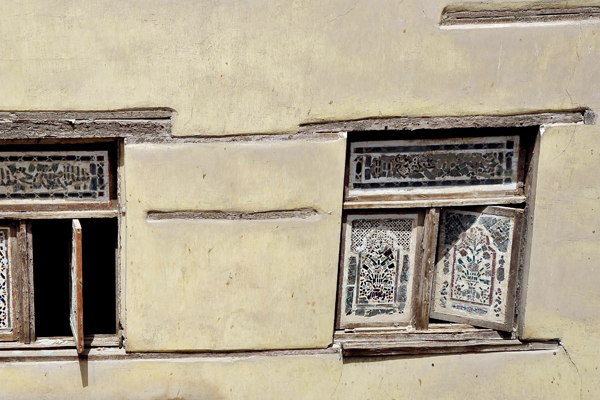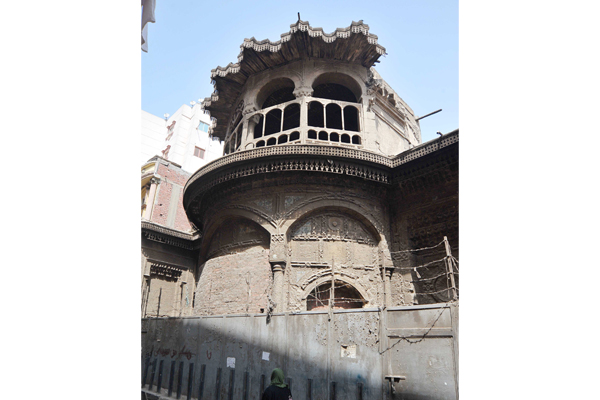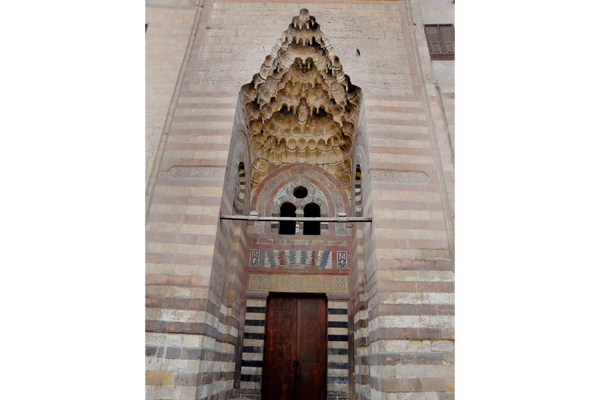At times they were confined to the constraints of the haramlek (women’s quarters), with its many societal synonyms, but more often than not they were resourceful, powerful and charitable.
This, said historian-guide Youssef Osama, is perhaps the best way of summarising the story of women during the Mameluke and Ottoman periods of Egypt and from the 13th to the 19th centuries.
According to Osama, the norms of the time were undeniably conservative, and society was generally male dominated. However, he said that there were many women in Mameluke and Ottoman Egypt who left major impacts on their times, including Shagarat Al-Dor, a female Mameluke ruler who reigned for 80 days in 1250 CE, and Nafissa Al-Baidaa, the spouse of two of Egypt’s last Ottoman-era rulers Ali Bek Al-Kabir and Mourad Bek, who lived between the 18th and 19th centuries.
Women had also played a significant role during the earlier Fatimid and Ayoubid dynasties that reigned from the late 10th until the early 13th centuries, he said. During the Fatimid period, women attended classes at Al-Azhar University in Cairo to learn about Shia Islam, and some of the mothers and sisters of male rulers had a considerable say in managing the politics of their time.
During periods of hardship in the Fatimid period, women took to the streets to protest against the economic policies of one of the dynasty’s rulers. However, Osama argued that the Mameluke centuries saw perhaps the most visible legacies, especially when it comes to architecture, of the women of those times.
“Most of the grand architecture we have in Cairo today belongs to the rule of the Mamelukes, and this is also the case of the grand monuments that were built by women or for women,” he said.

The interiors of madrassat Um Al-Sultan Ashraf
Osama was walking into the heart of Al-Darb Al-Ahmar just behind the Al-Hussein Mosque to find (the house of) Beit Zeinab Khatoun.
The house is associated with its last owner, an 18th-century lady who was originally a slave before being freed and married to Mohamed Bek Al-Alfi, one of Egypt’s last Mameluke emirs whose name is associated with the fight against the French Expedition to Egypt in the late 18th and early 19th centuries.
“There is so much that attracts visitors to this house. Students of art and architecture are fascinated by its design, and photographers are fascinated by the shadows produced in it from 8am to 5pm. Everyone shares an infatuation with the history of the last lady to have owned the house,” Ahmed, the inspector assigned to the building by the Ministry of Antiquities, said.
The name of Zeinab Khatoun is associated with the history of the Egyptian resistance to the troops of Napoleon that came to Egypt in 1798 with the French Expedition. She is remembered as one of the women who offered support to those who resisted the French from Upper Egypt to the northern cities of the Delta.
Zeinab Khatoun allowed members of the resistance movement to find refuge in her house when wounded or trying to escape from the French soldiers. She also provided financial help to the resistance movement at the time, Ahmed said.
One day in the early part of the last century, Ahmed added, during restoration work on the house a mass grave full of bodies was found in a room near the entrance.
Ahmed said there was debate among historians about whether they were the bodies of members of the Egyptian resistance who had come to hide in the house of Zeinab Khatoun and had died of their wounds, or whether they were the bodies of French soldiers killed by the resistance movement.
“They could be either, but this shows that this woman was a player in the resistance movement. This is the point I am interested in, since it shows that not all women at that time were confined to the haramlek and not all of them were ignorant about what was going on in the country outside,” Ahmed said.
According to Osama, the history of the last owner of the building gives added charm to a house that has an unmistakable architectural design. “It is one of the better-maintained monuments in Al-Darb Al-Ahmar, especially since it is now used to host cultural events,” he said.

The windows of Beit Zeinab Khatoun
SOUQ AL-SELAH: Originally built in the 15th century for one of the ladies of the ruling Mamelukes, the house overlooks Mohamed Abdou Street, named after a late 19th- century Egyptian scholar who put forward liberal readings of religion on many issues, including the status of women in Islam.
The house is adjacent to several other Mameluke-era monuments. But Osama chose to walk west in the direction of the Souq Al-Selah (the weapons market), which was the area in which swords and other weapons were made until they were replaced by guns.
Today, the Souq Al-Selah is the venue for all types of small stores and cafés. The walk is interrupted by many stops to take photographs: the entrance of a late 19th-century building that still has a bell for visitors to announce their arrival; a large plastic dish with five pottery pots for passersby to drink water; a group of girls playing up and down an old stairway that could well date to the 18th century; and an elderly man having his afternoon tea in the last days before the advent of Ramadan and offering a bit of cold water to a cat enjoying the shade.
“This area is not widely marked on the itinerary of visitors, but it is a very friendly walk, nonetheless. It is often taken by students of history who can still see many remnants of 18th and 19th-century Cairo,” Osama said.
He is heading towards the Madrassat Um Al-Sultan Shaaban, “another Mameluke monument associated with the name of another lady of that time”.

Sabil Roukaya Doudou
UM AL-SULTAN SHAABAN: According to an article by historian Walaa Al-Nabarawi, there are several beits, madrassas (school-mosques) and sabils (water fountains) in Islamic Cairo that stand as testimony to the fact that this period had many great women.
Women at the time, Al-Nabarawi says, whether from the ruling elite or from among female slaves or even from rich families, were often granted the right to build houses for charity, whether for education, water fountains, or places for worshippers to stop on the road. The construction of these buildings was either ordered by the ladies themselves or by their relatives, whether men or women.
According to Al-Nabarawi, the buildings are testimony to the status of these women, despite the fact that they would generally be quite protected, especially in the higher echelons of society, to the extent that often it was considered inappropriate for their names to be revealed by their male relatives or for their faces to be revealed without a bourqo (a face covering in black or white fabric).
The Madrassat Kuttab (a Quran school for young children), and Sabil Um Al-Sultan Shaaban overlooking Bab Al-Wazir Street was built in the 14th century by the Mameluke Sultan Al-Ashraf Nassereddin Shaaban for his mother Khound Baraka who died after performing the pilgrimage to Mecca.

The salamlak of Beit Zeinab Khatoun
According to Osama, the complex makes striking use of engravings and metalwork on the windows and the entrance, which is typical of buildings that have an association with women at that time. “The entrance of the sabil has a traditional drawing of two breasts symbolising a mother’s instinct to feed a hungry child,” he said.
This is not a very frequented mosque. Hassan, a worker in a small shop opposite the sabil, said that the place “particularly attracts the poor, the lonely, and the homeless. I often see them coming to find refuge and get a drink of water, and often enough there is a generous man or woman who will offer food for charity. I think this has to do with the fact that this place was built as an act of charity from a son to a mother. This is what we believe,” he said.
The entrance of the madrassa is cool on an otherwise warm afternoon. It invites Osama to perform his prayers before resuming the walk towards the sabil of Roukiya Doudou, another lady whose name is engraved on one of “the most beautiful pieces of Ottoman architecture in Islamic Cairo”.
Her mother Badawiya Shahine built the Sabil Roukiyah Doudou as an act of charity in the form of an 18th-century building towards the end of Souq Al-Selah Street. The walls of the buildings refer in their inscriptions to Badawiya Shahine. “There is no reference to the father, and we are not sure why, but we do know that Badawiya Shahine was married to Radwan Katkhuda who was killed in a political feud prior to the death of his daughter,” Osama said.
He added that some historians had suggested that Badawiya Shahine might have deliberately chosen not to engrave the name of the father of Roukiya Doudou, as would have been traditional by the norms of the time, in order to avoid antagonising those who had been her husband’s opponents.
“But the real story here is that we have a woman who built a monument for another woman,” Osama said.
Today, Osama argued, perhaps none of the children attending the primary school of Al-Rifaai, named after the grand Sufi saint whose shrine is only a half hour’s walk further west from the Sabil Roukaiya Doudou, might know anything about this lady or any of the ladies whose names are still engraved on the walls of the district’s monuments.
“This is very unfortunate: most people only know Shagaret Al-Dor, and maybe they do not perceive her in a positive light despite the role she played when her husband, the last of the Ayoubid sultans (Nejmeddin Ayoub) died while his troops were in battle against the European Crusaders,” Osama said.
Shagaret Al-Dor kept the death of the sultan a secret to avoid the demoralisation of the troops and to avert a palace struggle among potential successors while the son and heir of Nejmeddine Ayoub was far away in the Levant.
“This is an extraordinary political role that is never fully highlighted,” Osama said.

The façade of Sabil Um Al-Sultan Ashraf
BEYOND THE BOURQO: According to historian Ahmed Abdel-Razek, the women of the Mameluke dynasties, whether those of the ruling elite or of the wider society, were not necessarily as constrained as might be assumed.
It is impossible, Abdel-Razek argues in a book published by the General Egyptian Book Organisation called Women in the Mameluke Age, to imagine that the Mamelukes, with all their marvellous architecture, promoted a social system that was entirely biased against women.
Apart from the women of the palaces and the aristocracy, who might not all have been of Egyptian descent, Abdel-Razek argued, women in Egypt at that time were not without rights. Many ordinary women worked, for example, he said.
While it is true that they were constrained to take jobs related to beauty, marriage, childbirth and child rearing, they were not confined to their houses as they frequented public baths and markets and joined pilgrimage processions and national celebrations like Sham Al-Nessim when families went to the Nile to enjoy the beginnings of spring.
The titles that the upper-middle and upper classes granted to women, such as Baraket Al-Molouk (blessings of kings), and the names the families chose for their daughters, like Sit Al-Nisaa (lady of ladies), also indicate appreciation of women, he said.
The fact that families of great wealth, whether from the ruling elite or from outside it, granted their women large amounts of money to spend is another indication of the status of some women in the Mameluke era.
Even the sex workers and women slaves of the era, Abdel-Razek said, were not deprived of some status. Some women slaves (al-gawary) were mistresses in the courts of the Mameluke sultans, and they could have real influence over their decisions, including amnesties for prisoners and reducing taxes.
According to Osama, this was unchanged during the later Ottoman period. In fact, he said, women at that time were granted advanced legal rights, especially when they had to do with marriage, divorce, and contractual conditions imposed on the marriage partner.
“They wore the bourqo for the most part, and often enough they would be staying in the haramlek, but this did not mean that they were necessarily stripped of their power,” Osama argued.
“What the history books tell us in direct terms about the women of these centuries is perhaps very little, but we can learn a lot more by looking at the architecture they left behind, the marriage contracts they signed, and the account books they kept. All this tells us a lot about their real status,” he added.
*A version of this article appears in print in the 23 May, 2019 edition of Al-Ahram Weekly under the headline: In search of historical women
Short link: